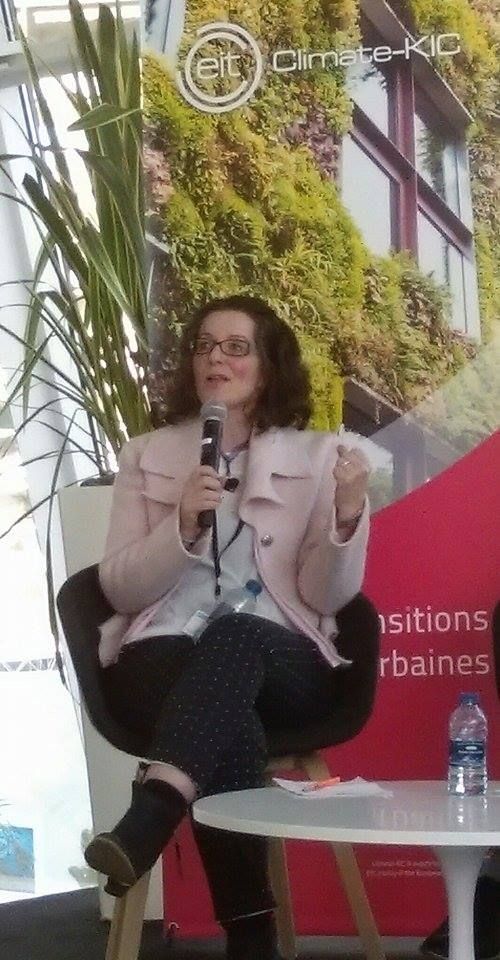Climate-KIC supports 9 pioneering cities to create Smart Sustainable Districts

Clare Wildfire, Project Director at Mott MacDonald Fulcrum, presents the Smart Sustainable District Programme led by Climate-KIC in Europe to help cities to come up with solutions against climate change and to create desirable cities.
People heard about smart cities, about sustainable districts, what is a Smart Sustainable District?
A smart sustainable district is characterised by low carbon mobility, smart grids, energy neutral buildings, efficient water management and accessible, public green space, all underpinned by responsive technologies that optimise resources. A smart sustainable district also promotes wellbeing and sustainable lifestyles, and facilitates new ways of working, commuting, consuming, interacting and enjoying the city.
 How does the SSD programme help to achieve their goal of a smarter and more sustainable cities and who are the stakeholders involved in this programme?
How does the SSD programme help to achieve their goal of a smarter and more sustainable cities and who are the stakeholders involved in this programme?
Smart Sustainable Districts is a group of pioneering city districts working together to deploy and accelerate the knowledge, expertise and best practice needed to transition to zero-carbon living and build resilience into Europe’s cities.
While conventional green development strategies tend to be led by master developers or agencies, district developments often demand wider collaboration and input from a diverse range of stakeholders. The Smart Sustainable Districts programme acts to bring together consortiums of policymakers, local municipalities, utilities, private developers, innovation experts, sustainability specialists and citizen groups. The SSD network offers support and services to create the dialogue, test the beneficial impact and help realise sustainable, district-led development.
Typical district projects and innovations include smart grids, district energy and heating, drainage and water management, rainwater harvesting, green streets, zero waste programs, district composting, waste-to-energy, car sharing, biking and bike lanes, urban agriculture,
culture and events, local maps and data interactions. Smart Sustainable District developments are guided by the concept of ‘factor four’ – the idea of leveraging twice the value with half the resources. Goals can include local job creation, boosting local business, improving community participation or inspiring new patterns of citizen behaviour, as much as enhancing environmental performance.
The typical outcomes of Smart Sustainable Districts include frameworks and implementation strategies, implementation tools and processes, methods of assessment, ways to raise capital, and recommendations to help develop the incentives and policies needed to scale up district development. For example, SSD work in Berlin demonstrates how sharing data instruments can bring transparency in multi-level governance and involves citizens in decision-making. In Paris, SSD has facilitated the local community in co-designing their own tools to help monitor construction and development, while SSD in London has advanced the applications of data to the concept of smart park‘.
What districts participate to the SSD programme and what led Climate-KIC to select them? What differentiates them and what challenges do they face ?
Smart Sustainable Districts currently has nine districts within its network – Rotterdam’s Stadshaven Harbour, Utrecht The New Centre, London’s Queen Elizabeth Park, Paris’ Les Dock de Saint-Ouen, Gothenburg’s Johanneberg, Malmö southeast, Berlin Moabit West, Helsinki’s Kalasatama and Copenhagen Energy Block. The selection process covered criteria such as level of ambition, scale of opportunity, degree of local stakeholder commitment, scalability and replicability. A few of the districts and the associated SSD activities are outlined below; further information can be found here: https://www.youtube.com/watch?v=ecBOzxmloHE
Over the coming year, the Smart Sustainable Districts programme is looking to expand into southern and eastern Europe.
Queen Elizabeth Olympic Park (QEOP) is a major urban district development in London regenerating the east end of the UK capital, positioning it as a new social and economic hub. Having hosted the 2012 London Olympic Games, the park is looking to build on its Olympic legacy. It is home to five world-class sporting venues, including the Zaha Hadid London Aquatics Centre and the Copper Box Arena. It is responsible for creating 10,000 new homes, a world-class cultural and education district, and a digital and media business hub. Smart Sustainable Districts (SSD) has helped advance QEOP’s work on resource-efficient buildings, energy systems and developing a smart park.
Moabit West is an inner city district in Berlin, home to both domestic-residential and industrial activity. As part of Climate-KIC’s Smart Sustainable Districts programme, the district project is working to take the first steps in implementing The Green Moabit 2013 urban development plan. The development is driven by ambitious sustainability goals for energy efficiency in manufacturing, electric commuter mobility and sustainable water management, with a District Data Atlas and citizen engagement strategy at its core.
Utrecht The New Centre is a district within Climate-KIC’s Smart Sustainable Districts programme exploring ways to plan sustainability into long-term city planning. The municipality of Utrecht and landowner Jaarbeurs are working to co-develop, pilot and test new district-scale integrated energy, water, mobility and building approaches. These integrated district-scale systems include Aquifer Thermal Energy Systems (ATES) for district heating and cooling, locally produced renewable power including photovoltaic (PV) panels, sustainable mobility, water management, city greening and enhanced connectivity.
Docks de Saint-Ouen in Paris comprises the regeneration of an industrial dock site. The SSD programme focused on consulting with the early inhabitants of this multiphase development, the result being an innovative collaborative web based application called NUM-CITY, providing communication and information services based on the spontaneous and regular collection of data by the citizens: inhabitants, workers, businesses. The data includes collection and processing of information related to energy consumption, waste sorting, local good exchanges and air quality within the district.
EnergyBlock Copenhagen is harnessing the input from local ecosystem and international experts to utilize real time data streams in the setting up a Blockchain infrastructure, to enable local connections of production and consumption of energy.
How do you measure the contribution of the SSD programme to fight against climate change?
Due to the integrated nature of our programme we have many different outcomes to measure across many different metrics, such as CO2 reduction or improved flood resilience, and also across different scales and timescales. As one example, the Docks de Saint-Ouen distirct, the NUM-CITY solution enables the districts habitants to measure their electricity, gas and hot and cold water consumption, with energy efficiency challenges between various buildings stimulating whole district improvement. On a programme wide basis we have chosen the CITYKeys platform (http://www.citykeys-project.eu/ ) from which to source our main palette of performance indicators, but we are still learning the best way to apply them across districts that have such different objectives and SSD focuses. There are also many less quantifiable benefits such as (1) the enhancement of stakeholder or citizen trust, which results in faster implementation of sustainable measures; (2) reputation, which encourages replication and take-up elsewhere; and (3) local relationships and empowerment, which ensures a continued commitment over the long term.
Read more about the SSD Programme



